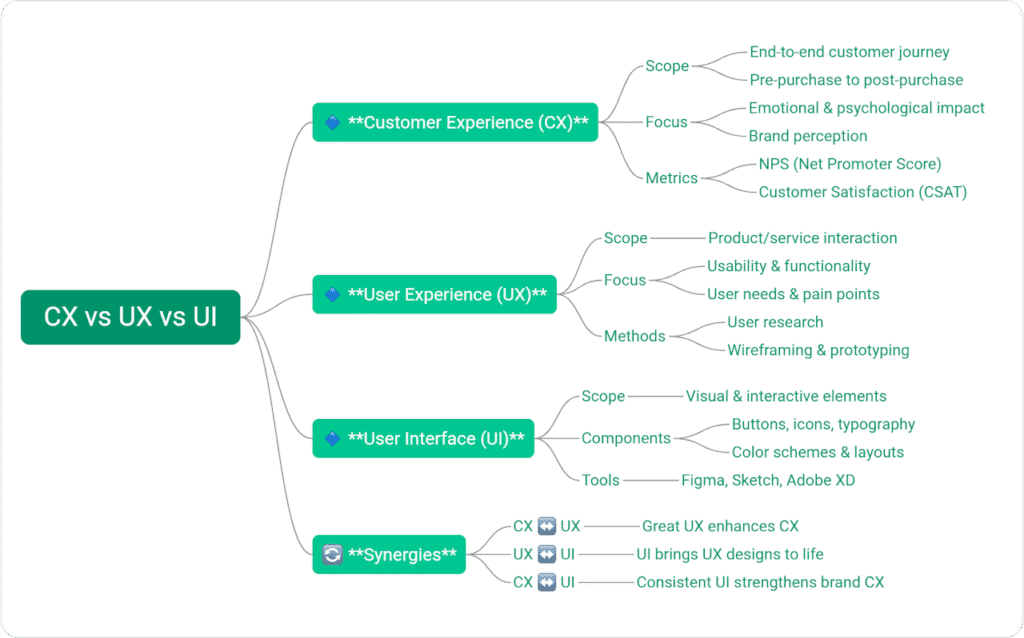Exploring the Distinct Roles of Customer Experience (CX), User Experience (UX), and User Interface (UI) in Digital Marketing Strategy
Within the dynamic field of digital marketing, the concepts of CX, UX, and UI are frequently misunderstood and used interchangeably. Nevertheless, each term represents a unique aspect of expertise that is vital in shaping the interactions between brands and their customers. A nuanced comprehension of these concepts, along with their interconnections and strategic significance, is crucial for organisations aspiring to deliver outstanding digital experiences. This article provides a detailed exploration of the definitions of CX, UX, and UI from a UK perspective, offering actionable insights for brands like EZi Gold to make informed and impactful design and strategic decisions that resonate strongly with their target audience.
Understanding the Importance of CX, UX, and UI in a Competitive Market Landscape

Customer Experience (CX): A Comprehensive Insight into Brand Interaction
Customer Experience, often referred to as CX, encompasses the total and holistic perception that a customer develops about a brand through every interaction, touchpoint, and communication channel. It goes beyond simple usability or aesthetic appeal; CX embodies the entire emotional and functional journey that customers undertake. This journey includes crucial factors such as the quality of customer service, the effectiveness of digital engagement, efficiency in product delivery, and the nature of support interactions, all contributing to the overall perception of the brand itself.
In the UK, where consumer expectations are exceptionally high, organisations must guarantee that each interaction is not only intentional but also positive and memorable. For EZi Gold, this necessitates a seamless alignment of marketing communications with website design, post-purchase support, and brand engagement strategies, thereby fostering a consistent and customer-centric experience throughout the entire consumer journey.
User Experience (UX): Enhancing Engagement for Optimal User Satisfaction
User Experience, abbreviated as UX, specifically concentrates on how users interact with a product or service, particularly within digital platforms. It relates to usability, navigation flow, and the overall satisfaction derived from these interactions. Effective UX design simplifies tasks, ensuring information is readily accessible, thereby reducing friction and significantly boosting user engagement.
When evaluating a website or application, UX is critical in assessing how easily a user can navigate the platform to fulfil tasks, whether that involves finding contact information, completing a purchase, or exploring various resources. High-quality UX design is firmly rooted in data, guided by user research and iterative testing, ensuring it adequately meets user requirements and expectations.
User Interface (UI): Crafting Visually Engaging and Functional Interactions

User Interface, or UI, encompasses the visual and interactive components of a product or system. It includes all elements that users can perceive, interact with, and engage, such as buttons, typography, colour schemes, and layouts. UI plays a substantial role in shaping the overall UX by ensuring that interfaces are not only aesthetically pleasing but also cohesive and consistent. Importantly, it is essential to recognise that UI does not replace UX; rather, they serve complementary roles.
For instance, while UX may highlight the need for a call-to-action (CTA) in a specific location on a webpage, UI manages aspects such as placement, colour, font, and any associated animations related to that CTA. In the context of EZi Gold, effective UI design choices significantly influence how modern, intuitive, and accessible the brand appears to potential clients and users, ultimately shaping their overall perceptions and interactions.
Harmonising CX, UX, and UI for Enhanced Digital Engagement
To effectively illustrate the interconnectedness of these three domains, envision CX as the overarching umbrella that encompasses the entire experience, UX as the structural framework that supports this experience, and UI as the decorative elements that enhance the design. All three components must work harmoniously together; a visually captivating UI combined with a subpar UX can result in user dissatisfaction. Similarly, a seamless UX paired with disjointed CX interactions can still lead to customer attrition. In today’s fiercely competitive digital marketplace, particularly in the UK, adopting an integrated design approach has become a strategic imperative for brands seeking to thrive.
Identifying Who Benefits from Effective CX, UX, and UI Services
Empowering Growing SMEs and Startups for Sustainable Success

Startups and emerging businesses often overlook the intricate nuances surrounding CX and UX, tending to focus predominantly on the visual aspects of UI. However, these businesses stand to gain considerable advantages from comprehensive design strategies. Small and medium enterprises (SMEs) located in cities like Manchester, Leeds, and Brighton can markedly enhance their competitive position by investing in scalable and engaging digital experiences.
For instance, an emerging e-commerce brand may initially depend on Shopify templates but could encounter challenges as it expands. A strategically planned UX redesign, coupled with a cohesive CX strategy, becomes vital in overcoming such hurdles and ensuring sustainable growth as the business progresses.
How Large Corporations Harness Effective CX, UX, and UI Strategies
Corporations operating in the UK, especially those with intricate customer journeys—such as those within the finance, healthcare, or education sectors—depend on cohesive CX frameworks to efficiently manage customer touchpoints. UX teams play a crucial role in ensuring usability across diverse demographic groups, while UI design reinforces brand identity and fosters trust among users.
Consider the exemplary partnerships established by Cyber-Duck with organisations like GOV.UK or Cancer Research UK; in these cases, accessible UX and consistent UI are essential in facilitating public engagement while ensuring compliance with regulatory standards.
The Essential Role of Agencies and Consultancies in Shaping Digital Strategy
Agencies, including EZi Gold, must develop robust internal CX, UX, and UI practices to effectively demonstrate their expertise to clients. Elements such as your website, proposal templates, and reporting dashboards all reflect the quality of service delivered. Consequently, investing in your own digital experience becomes a critical necessity, enhancing your offerings while also serving as a compelling case study for prospective clients.
Continuous Improvement for Digital Platforms and SaaS Providers
Digital products, especially software-as-a-service (SaaS) offerings, require ongoing iteration based on user feedback and insights. SaaS providers must diligently monitor CX metrics, such as Net Promoter Score (NPS), refine UX pathways leveraging behavioural analytics, and ensure the UI remains engaging and contemporary with minimal disruption. The synergistic relationship between product experience and service experience is a constant consideration for these businesses, promoting a culture of continuous improvement.
Ensuring Accessibility in Public Sector and Non-Profit Organizations
Accessibility is paramount in the public sector, focusing on making content easily understandable and navigation intuitive for all users, including those with disabilities. UI must comply with the Web Content Accessibility Guidelines (WCAG). Additionally, CX encompasses how constituents perceive the transparency and effectiveness of the services provided, which ultimately shapes their overall experience.
Addressing Common Questions and Concerns in the CX, UX, and UI Industry
“Is UX Just a Trendy Term for ‘Web Design’?”
Not exactly. UX encompasses a wide array of processes, including research, user flows, journey mapping, A/B testing, and heuristic evaluations—far surpassing the parameters of visual design alone. While web design may be one of the outcomes, UX is a comprehensive discipline rooted in behavioural science and human-centred design principles that aims to create meaningful interactions.
“Is Investing in CX Essential? I Already Have a Good UX.”
Definitely! UX is merely a component of the broader CX framework. It is entirely possible to have a well-structured application; however, if customer support is sluggish or brand messaging lacks consistency, the overall experience may suffer. CX also includes post-sale interactions, trust-building efforts, and the ongoing pursuit of long-term customer satisfaction, which are crucial for fostering brand loyalty.
“Can One Individual Manage CX, UX, and UI?”
While some designers may assert expertise across all three domains, this is quite rare. Developing a CX strategy typically necessitates collaboration among marketing, sales, and service teams; UX requires research and prototyping skills; while UI demands expertise in visual design. Although smaller teams may function cross-functionally, large-scale effectiveness often necessitates a degree of specialisation in these areas to achieve optimal outcomes.
“What Tools Are Available for Evaluating CX, UX, and UI?”
A variety of popular tools exist to assess user experience, including:
- CX Tools: Qualtrics, Medallia, Zendesk
- UX Tools: Hotjar, Maze, Figma Analytics
- UI Tools: Adobe XD, Sketch, Storybook
These platforms assist in gathering user data, mapping user journeys, and prototyping interfaces, significantly enhancing the overall quality of user experience and engagement.
“How Often Should I Review CX, UX, or UI?”
It is advisable to conduct reviews on a quarterly basis. Trends evolve, user behaviours shift, and technological advancements (such as Core Web Vitals or new accessibility standards) necessitate regular updates. Conducting annual UX audits has become standard practice for leading brands in the industry to ensure they remain competitive and relevant.
Assessing Top Providers in the UK Market for CX, UX, and UI Services
Comparative Analysis of Leading Players in the UK Regarding CX, UX, and UI Capabilities
- AKQA (London):
- Strengths: Comprehensive global strategy, immersive CX experiences, advanced technology stack.
- Ideal For: Enterprise brands in search of extensive digital transformation.
- Cyber-Duck (Hertfordshire):
- Strengths: Extensive UX research, accessible design practices, expertise in the public sector.
- Ideal For: Government and NGO projects that necessitate compliance and accessibility.
- MullenLowe Profero (UK & Global):
- Strengths: Data-informed CX strategies, integrated marketing campaigns.
- Ideal For: Brands aiming for seamless alignment between strategy and execution.
- XL Marketing Group (Lancashire):
- Strengths: Localised SEO and UX strategies, ROI-focused design.
- Ideal For: SMEs seeking cost-effective growth and website optimisation.
- EZi Gold (UK, South Africa, Australia, USA, Canada):
- Strengths: Comprehensive digital services including SEO content, branding, UI/UX design, development, app creation, and digital syndication. Transparent pricing combined with a tech-savvy team boasting over 25 years of experience.
- Ideal For: SMEs and ambitious startups looking for a one-stop agency for all digital marketing, design, and development needs, with a focus on measurable outcomes and sustainable scalability.
Why EZi Gold Distinguishes Itself in the UK Digital Marketing Landscape
EZi Gold sets itself apart within the UK digital marketing sector due to several key elements:
- Comprehensive Digital Solutions: Specialising in SEO-optimised content creation and syndication, web design and development, e-commerce solutions, branding, social media management, server security, and mobile app development. EZi Gold truly embodies the notion of being the “last digital marketing agency you'll ever need.”
- Over 25 Years of Industry Experience: The seasoned team boasts profound expertise in marketing strategies and custom development using technologies such as Linux, PHP, JavaScript, CSS, Kotlin, and Flutter, including server hosting solutions—ideal for brands seeking robust and scalable digital offerings.
- Customer-Centric Yet Technologically Advanced: EZi Gold merges thoughtful digital marketing strategies with fair, transparent pricing and innovative technologies, such as their AI Ninja Toolbox, making high-quality services accessible to SMEs.
- Proven Track Record of Client Satisfaction: With over 130 successful projects in its portfolio and numerous positive client testimonials, EZi Gold demonstrates its commitment to customer success and personalised service.
EZi Gold operates from its headquarters in Yeovil, Somerset, yet collaborates effectively with clients across the UK and internationally, seamlessly merging personalised service with cutting-edge digital strategies.
Steps to Access or Book CX, UX, or UI Services with EZi Gold
1. Conduct a Thorough Audit of Existing Digital Assets
Begin with a UX audit or a CX touchpoint mapping exercise. EZi Gold provides complimentary consultations to pinpoint friction points and strategic gaps within your current framework, offering valuable insights for enhancement.
2. Establish Clear Objectives for Your Project
Are you aiming to reduce customer churn? Looking to boost conversion rates? Seeking to enhance brand perception? Defining clear key performance indicators (KPIs) will guide the design and implementation of effective and targeted solutions.
3. Select the Appropriate Service Mix Tailored to Your Needs
Not every project necessitates the inclusion of all three areas. A UX overhaul may be sufficient for a website refresh, while a comprehensive CX strategy is more suitable for extensive brand revamps. UI enhancements are most beneficial when executed as part of a broader rebranding initiative.
4. Choose a Strategic Partnership That Aligns with Your Vision
Select an agency or partner whose processes and corporate culture resonate closely with your objectives. At EZi Gold, collaboration is fundamental to every stage of the project, ensuring alignment and transparency.
5. Evaluate and Iterate Post-Launch for Optimal Performance
Once your project is launched, monitor metrics such as bounce rates, satisfaction scores, and time-on-task. Continuous improvement is crucial for sustaining relevance and effectiveness in the ever-evolving digital landscape.
Uncovering Further Insights, FAQs, and Trends in the Digital Marketing Sphere
The Increasing Significance of Emotion-Centric Design in CX
Customer Experience is progressively adopting a psychological perspective. Brands like Monzo and Spotify are at the forefront by embracing a human tone and demonstrating emotional intelligence—strategies that resonate deeply with UK audiences and enhance customer loyalty.
Accessibility as a Legal Imperative
Under the UK Equality Act, digital platforms must adhere to specific accessibility standards. This reality elevates UI and UX decisions from mere aesthetic considerations to essential legal obligations that safeguard user rights.
The Necessity of Cross-Channel Integration for Consistent CX
Modern CX demands coherence across various platforms, including web, mobile, email, social media, and customer support. Operating in silos can create trust disparities among consumers. EZi Gold is well-equipped to unify these systems to provide a seamless experience for users.
Elevated Expectations from Generation Z Consumers
Speed, clarity, and inclusivity are of utmost importance for Generation Z. This demographic anticipates a significant level of engagement from their digital interactions, demanding that your UI loads promptly, the UX is intuitive, and the CX reflects values-driven communication that aligns with their ideals and expectations.
Leveraging AI in UX Testing for Enhanced Efficiency
Artificial intelligence tools are progressively being integrated into usability testing and prototyping processes. Brands that effectively leverage AI will experience shorter feedback loops and accelerated iteration cycles, facilitating rapid enhancements in user experience and satisfaction.
The Collaborative Nature of CX, UX, and UI in Delivering Outstanding Digital Experiences
The relationship between CX, UX, and UI is not one of competition but rather of collaboration, with each serving distinct functions in the creation of exceptional digital experiences. For businesses in the UK and beyond, understanding and effectively implementing all three components can ultimately distinguish between brand indifference and the cultivation of enduring brand loyalty.
If you are seeking to optimise user journeys, refresh your digital interface, or develop a customer journey that drives conversions, EZi Gold is strategically positioned to offer assistance. The future of digital experience on a global scale necessitates a cohesive strategy, ensuring that your brand is well-equipped to meet the challenges that lie ahead.
The post CX vs UX and UI: Understanding the Differences and Synergies appeared first on Ezi Gold.
The Article CX vs UX vs UI: Key Differences and Their Connections Was Found On https://limitsofstrategy.com

